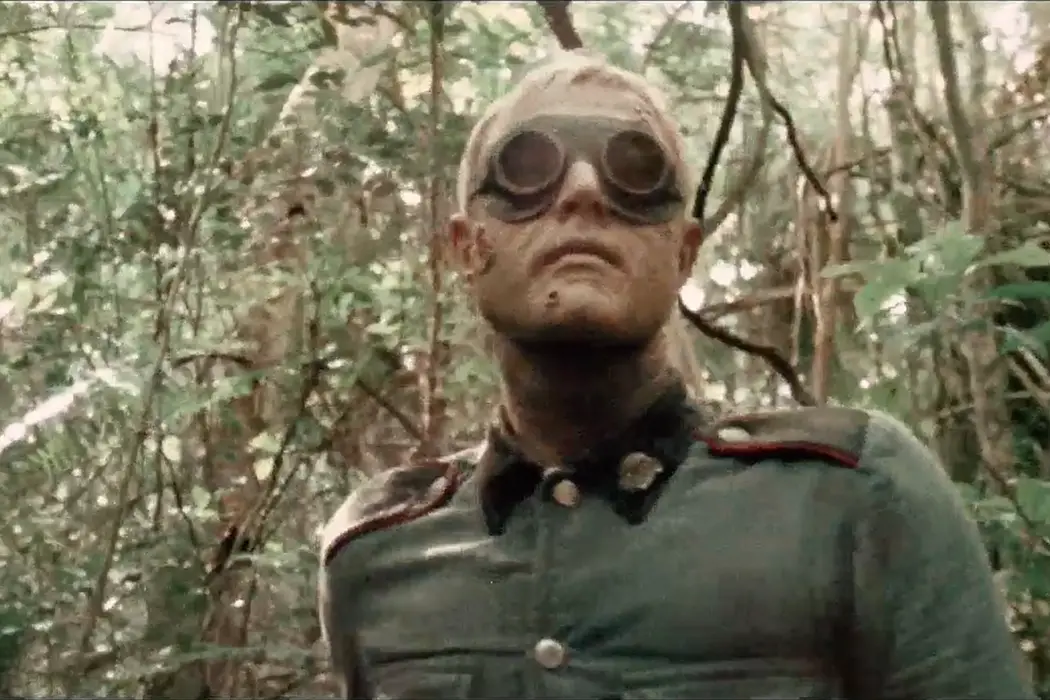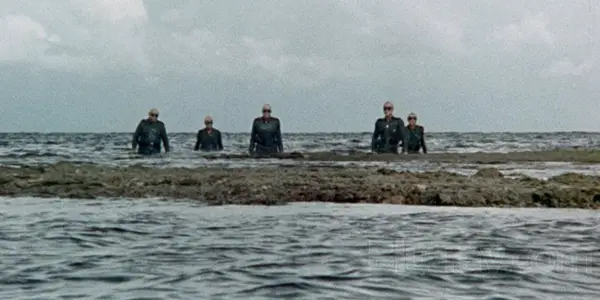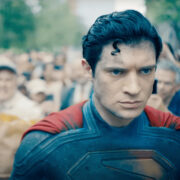Baby Boom: SHOCK WAVES & The Greatest Generation

Brian Brems is an Associate Professor of English and Film…
Despite basically inaugurating the Nazi-zombie subgenre, Ken Wiederhorn’s 1977 film Shock Waves has mostly been left to decay. The film’s story follows a group of tourists on a boat trip in the Caribbean who run afoul of a squad of undead S.S. super-soldiers loosed from their underwater tomb. The tourists seek refuge on a deserted island inhabited by only a mysterious old man, a scarred S.S. commandant (Peter Cushing) who warns them of the horror that awaits them if they remain. A fairly straightforward horror structure takes over, as the survivors are picked off one by one at the hands of the advancing Nazi ghouls.
The moment of its release betrays numerous sidelong influences, including Steven Spielberg’s Jaws (1975), which not only spawned more direct imitators like Orca (1977), Tentacles (1977), and Piranha (1978) in the revenge-of-the-violent-underwater-creature mold, but also its beneath-the-sea photography, which Shock Waves uses for point-of-view shots of the zombies early in the film. In addition, the film relies on the slasher plot device of the group in a remote, unfamiliar place, not unlike Tobe Hooper’s The Texas Chainsaw Massacre (1974). Though the movie looks and sounds an awful lot like standard exploitation fare, it largely eschews gore and sexuality, instead creating an atmospheric and unnerving experience owing mostly to the nightmarish representation of its Nazi zombies, who are coldly efficient killing machines.

In this way, the zombies deviate from the George Romero tradition, which he established with 1968’s Night of the Living Dead and, as Shock Waves was hitting theatres, was on the cusp of revisiting with 1978’s Dawn of the Dead. Wiederhorn’s ghouls have no interest in eating the human flesh of their victims, but return from their watery grave only to perform their essential function – killing. Romero is often rightly credited with making his zombies perform a social or political function. He operationalizes their narrative meaning by folding them into a larger critique of the moment. In Night, the zombies become a reflection of Vietnam-era violence and, in its closing moments, a frighteningly human justification for racial demonization, as Ben (Duane Jones), the film’s black hero and only survivor, is gunned down by a mob of zombie hunters after being mistaken for one of the shambling undead.
In Dawn, Romero’s undead roam a massive shopping mall, their brainless desire for the consumption of flesh aligned with his humans’ desire for the same with consumer goods. The unjustly neglected Day of the Dead (1986) engages with questions of militarism and the morality of science in a Cold War-centered fable, as his human survivors try to hang on to life inside an empty nuclear missile silo. Land of the Dead (2005), not the last of Romero’s zombie pictures, but the final marquee one, becomes a post-9/11 parable about an ivory tower of the super-rich who ignore the problem beyond their fortress in favor of a luxury lifestyle. Taken together, these four major Romero zombie films perform a forty-year left-leaning critique of the American global order, both at home and abroad, each through the device of the same hungry monsters.
Wiederhorn will never and has never been granted (nor earned, really) the status of auteur royalty in the horror genre like Romero has, but Shock Waves fits neatly into the social and political tradition espoused by Romero’s films. Like Romero’s quartet, Shock Waves’s zombies say something about the cultural moment during which they return to life. Not only does it demonstrate living engagement with the genre’s evolving conventions at a moment when horror was creeping towards stronger legitimacy by auteur filmmakers like Romero, Hooper, John Carpenter, and Ridley Scott, it uses its unique concept to offer commentary on the cultural anxieties of post-Vietnam America. Unlike Romero’s zombie films, Shock Waves has slipped through the cracks. However, it is an essential complement to those zombie films in its innovative use of the monster. A wave of Romero imitators would follow in the wake of the popularity of Dawn, but Wiederhorn’s film precedes it, leaving him free to offer a now seemingly non-canonical representation of the undead that gives the film a retrospective freshness.
Hammer & Sickle
Shock Waves was made for little money, and it shows in the charming late 1970s way that characterizes many of its horror contemporaries. Also characteristic of this period of horror is the inclusion of a pair of legacy stars from an earlier era of filmmaking. One, the aforementioned Cushing, carries with him the history of his appearances in numerous horror films for the British studio Hammer, in which he played many of the classic horror cinema roles in late 1950s and 1960s updates: Dr. Frankenstein and Dr. Van Helsing, most notably. His appearance as Grand Moff Tarkin in Star Wars the same year as Shock Waves must have been quite an experience of double-consciousness, as Cushing spent some time on George Lucas’s massive sets before it became the biggest movie in the world, and then turned in four days of work in Florida for Wiederhorn, despite receiving top billing. In both films, of course, there is the looming specter of fascism.
Tarkin is the executioner of a genocidal regime, ordering the extermination of Alderaan from the Death Star in a moment of untroubled evil. His unnamed Commandant in Shock Waves speaks for the now extinct Nazi Reich, who created the S.S. super-soldiers only to see them lose control and turn on their creators in a Frankensteinian echo of Cushing’s earlier Hammer career. In each, the weapon is turned against the master – a fatal flaw in the Death Star leads to its destruction by the rebels, with Tarkin confidently aboard its bridge and defiantly unwilling to abandon his ship. His Commandant is likewise done in by his own creation, as a zombie pulls his face beneath the water and drowns him about two-thirds of the way through Shock Waves’s running time.

Both Star Wars and Shock Waves carry overtures of Vietnam. For all of our cultural association with Star Wars as the paradigmatic of uncritical, conservative cinema (its villain is literally dressed entirely in black, its hero entirely in white), it is easy to forget that Lucas has spoken at length about his intent to create a parallel between the Galactic Empire and the United States, with his Rebel Alliance performing the role of the Vietcong.
Though his original sympathies with the Communist North Vietnamese rebels has surely been replaced by his love of the royalty checks he receives from the sale of Han Solo action figures, Lucas had Vietnam on his mind, just as most of the country did in the aftermath of the fall of Saigon in April of 1975. With the last Americans leaving the embassy, and the dramatic images of the rescue helicopters being shoved into the sea from the landing decks of U.S. aircraft carriers to make room for more refugees, Americans began reckoning with the fallout of the last ten years of their misadventure in Southeast Asia. In that moment, the entire war effort and the thousands of Americans killed and wounded, to say nothing of the devastation visited upon the Vietnamese people, all must have seemed as if it were done in vain.
Generation Gap
The relative youth of most of the cast of Shock Waves makes them baby boomers through and through. With the exception of Cushing, the other two oldest cast members are John Carradine, who plays the tour’s boat captain, and Don Stout, who plays its cook. The other survivors are each in their late twenties or early thirties, within the general age range that would have served in Vietnam. The other, older cast members, though this information is never offered in dialogue, are characterized as vestiges of the greatest generation, who stormed the beaches at Normandy or flew bombing missions over Germany. The captain’s sailing experience, as well as the cook’s seamanship, might be products of naval service during the war.
These are the men, the story’s setting suggests, who defeated Hitler’s armies and sent the Nazis to the ash heap of history. It is telling, then, that these two members of the greatest generation are the first to die. The captain goes missing and is discovered drowned, and the cook is stalked and killed by the zombies on screen. Without the experience of the men who have presumably fought against the Nazis before, who have been weakened by age in the intervening years and eliminated from the narrative, the baby boomers are left to fend for themselves against a reanimated foe bent on continuing its genocidal ambitions.
Shock Waves presents an alternative history where the Nazi menace was not quite defeated, but lies dormant and may be reawakened at any time. The tropical climate of the film’s setting, along with Cushing’s Commandant living in exile, evoke the long-held fear (in a few cases, accurate) that Nazis had escaped to South American countries and were living in anonymity, evading punishment for their crimes. The Commandant has not renounced his belief in the Nazi regime; his abandoned hotel hideout is draped in Nazi flags, a giant swastika hanging above his desk.
The zombies awaken from their undersea tomb, a rusted-out ship that the Commandant sunk before taking up residence on the island. In a shot that graces one of the film’s posters, a zombie wearing black goggles, his wrinkled face decayed from years of underwater imprisonment, slowly emerges from the water two years prior to a similarly framed shot of Willard (Martin Sheen) in Francis Ford Coppola’s Apocalypse Now. He is followed by the other members of his squad, all wearing gray Nazi uniforms and the same goggles, their blond hair a hallmark of their continued belief in their own genetic superiority.

The film generates horror through its construction of its horror set pieces, which emphasize the zombies’ expertise in violence. Unlike Romero’s shambling hordes, which move in relatively unmotivated herds, these zombies are precise. They don’t stumble, they stalk. They set traps. They lie in wait. They don’t have any interest in eating their victims; they exist only to kill, usually by pulling the unfortunate beneath the water. They strike when the survivors are alone and weak.
While Wiederhorn’s innovations with the zombie tropes are among the film’s most interesting features, his depiction of the human survivors illustrates the anxiety at the movie’s core. After the deaths of the captain and the cook demonstrate the severity of the stakes to the others, they are led by the ship’s first mate, Keith (Luke Halpin), who forms plans and tries to keep the others alive, including Rose (Brooke Adams), the film’s ostensible protagonist, who survives the action and is rescued from a lifeboat in the film’s framing device.
Among the others are bickering couple Beverly (D.J. Sidney) and Norman (Jack Davidson), neither of whom is handling the situation very well, and Chuck (Fred Buch), who eventually succumbs to a fit of claustrophobia before being killed by the zombies in the hotel’s empty swimming pool. The survivors refuse to work together to fight off the zombies, instead devolving into petty disagreements and squabbling, reducing their chances of survival. Before long, all of them, save Rose, are killed. She is spared death, but the film’s final moments show her in a hospital bed, traumatized and writing unreadable scratch on a notepad.
Shock Waves: Conclusion
In the wake of the end of American involvement in Vietnam, Shock Waves explores what might happen if a threat like the Nazis were to rise again. The film presents a world where the greatest generation is no longer able to provide help, and expresses doubt that the baby boomers would be able to unify against a common enemy. The division and infighting that marked the baby boomers’ experience of the Vietnam era, with the upheaval on college campuses and in cities generating nationwide protests against the war, have so riven the American spirit that pessimism reigns.
The other cultural fights of the prior fifteen years, including civil rights, the sexual revolution, and the resignation of President Nixon in the aftermath of the Watergate scandal, contribute to the country’s “crisis of confidence” that then-President Jimmy Carter would diagnose in a televised speech before the nation in 1979.
Wiederhorn’s mostly forgotten film is really about the fear of a fascist planet. Its Nazi zombies were buried at sea long ago, but have found their way back to the surface. Where the greatest generation succeeded, the baby boomers fail. Like many great horror films, it invites us to wonder what we would do in the same situation. If somewhere out there the surface of the water gave way, and a horde of Nazi zombies started advancing towards the shore, would we have the strength to unify, to transcend our differences, to gather around common ideas and beliefs, and beat them back? Shock Waves suggests that Wiederhorn doubted it.
What purpose does the Nazi-zombie super-soldier metaphor serve when used in films in a modern context?
Does content like this matter to you?
Become a Member and support film journalism. Unlock access to all of Film Inquiry`s great articles. Join a community of like-minded readers who are passionate about cinema - get access to our private members Network, give back to independent filmmakers, and more.
Brian Brems is an Associate Professor of English and Film at the College of DuPage, a large two-year institution located in the western Chicago suburbs. He has a Master's Degree from Northern Illinois University in English with a Film & Literature concentration. He has a wife, Genna, and two dogs, Bowie and Iggy.













